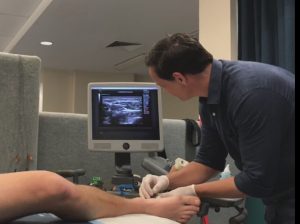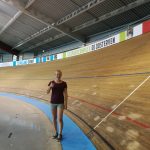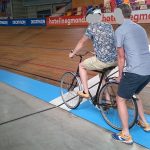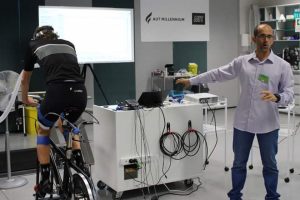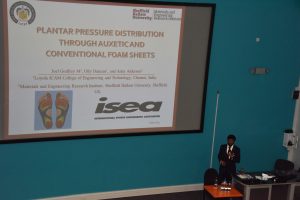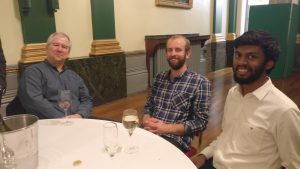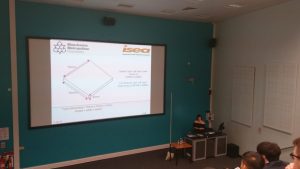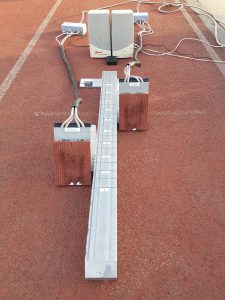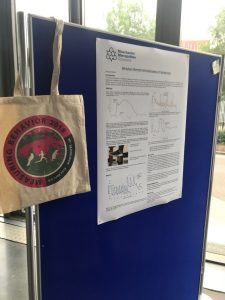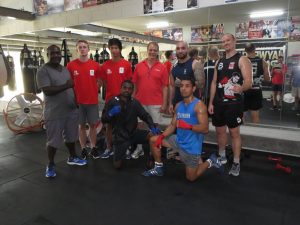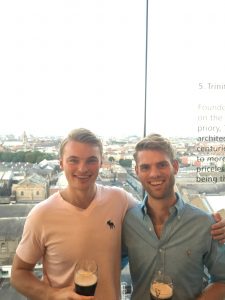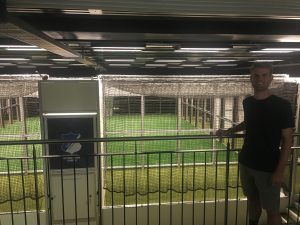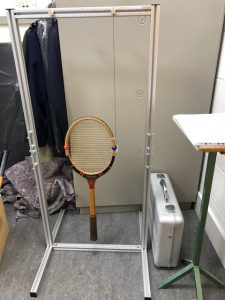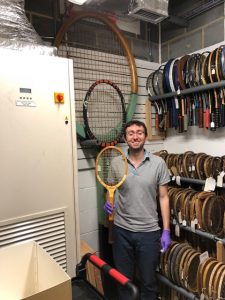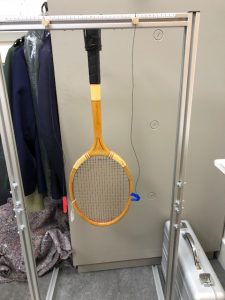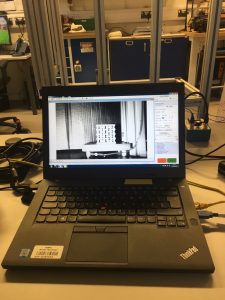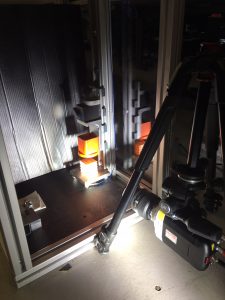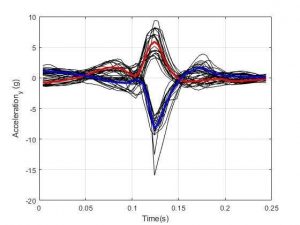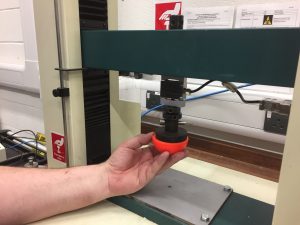Olly Duncan
Summary of the 5th UK Sports Engineering Seminar Day
After a two year wait, we were really pleased to welcome the community to Manchester Metropolitan University for the 5th UK Sports Engineering Seminar Day. More than 100 delegates came from around the UK and abroad (special mention to guests travelling from Canada), spanning backgrounds from mechanical engineering to art and design. Delegates included academics, students and industry/governing body representatives. The event was organised by members of the Sports Engineering Group at MMU, and affiliate members Adil Imam (Canterbury Christ Church University), Kristina Brubacher (University of Manchester) and Daniel Haid (Sheffield Hallam University). Funding was provided by the ISEA via the engaging sports engineers grant, and Manchester Metropolitan University via the business engagement team, while the IMechE also supported and promoted the day.
We began with tours of our various connected laboratories, Fashion and Textiles, Sports Mechanics, Institute of Sports, and Facial Reconstruction. Then PhD students kicked off the talks, with spotlight presentations to introduce them to the community. Max Valentine (University of Bath) won the prize for best student presentation, and Katie Mills (Sheffield Hallam University) the runner up prize – prizes were sponsored by PING and the ISEA.
We welcomed speakers from the UK, and international/EU speakers (roughly 50/50 between industry/governing body and academia). Topics ranged from mechanical metamaterials to wind tunnel testing. Special mentions to Siamak Khosroshahi from Queen Mary University of London, for the entertaining evidence of developments in impact testing ethics; linked to the prize for best tweet (Adam S Kennerley, Sheffield Hallam/Latrobe), and Stefan Mohr from HEAD – a favourite during verbal feedback. After the success of the last day at Sheffield Hallam University, we kept sessions to below two hours, leaving plenty of time for breaks and networking, which we felt worked well in 2020.

Left: Siamak Khosroshahi from Queen Mary University. Right: Stefan Mohr from HEAD.
It is clear that the UK has a strong up and coming generation of Sports Engineers. Now, the UK community will benefit from the conference in Loughborough in 2024, and a new venue for the 2023 Seminar Day (Canterbury Christ Church University). Discussion topics arising from the day related to collaboration on key cross-sport and disciplinary challenges around equipment for injury prevention, understanding current and sustainable rubber-free artificial turf, and improving collaborations between Academica and governing bodies. There are plenty of opportunities for our budding and established generations of sports engineers to further knowledge and impact in the discipline – we welcome any initiatives to build an even stronger community.
Feedback from the day was positive – talks, content and scheduling received very good or good ratings. We look forward to helping Adil Imam lead the next event, keeping many of the now tried and tested formats, while ensuring there are spare microphones for questions! Once again, thank you to all who came, helped and contributed – it really was great to see old faces again, and meet new community members.

Value: £2,500
University: Manchester Metropolitan
Patrick Mayerhofer
Wearables Course Workshop and Other Engagements
The student engagement award allowed me to visit the department of Sports Engineering at the Chemnitz University of Technology. During the trip, the main goal was to learn more about the work being done by the Sports Engineering group in Chemnitz, and to present and gather feedback on my projects . A main topic was the open-source remote wearables course that I co-developed at Simon Fraser University. The visit gave me a chance to present all the resources from this course, and provide the Sports Engineering department with an overview on how to best utilize on these resources for their own courses in Chemnitz. We had a great workshop, where participants also got some hands-on experience of the course.
For myself, I got some great feedback for the course, and for their department, they learned something that might potentially be integrated into their curriculum in one way or another. Additionally, I got to see the various research that they are currently doing in their department. I was particularly interested into their wearable sensor research that they are doing as part of a capstone project called hybrid-societies. Hybrid-societies is a collaboration of multiple departments at the Chemnitz University of Technology. The goal is to use the interaction of humans and machines to create a better life and lifestyle. The Sports Engineering department's projects are centered around measuring human movements and giving accurate environmental information and feedback to humans. Since my own PhD work is centered around measuring the performance of athletes and providing them with automatic and objective feedback, I was excited about their work. Lastly, I got a chance to see the town Chemnitz and its surroundings, such as the "Sächsische Schweiz", where we got to go on a hike close to the Czeck border. I hope that the connections that we built during this week can be utilized in future collaborations and projects.


Value: £500
University: Simon Fraser University
Manuela Paulina Trejo Ramirez
Visit to the University of Calgary and attendance to the Footwear Biomechanics Symposium
Aim of the visit:
To engage with academics from the University of Calgary, in order to gather suggestions and expertise for the upcoming studies of my PhD as well as to present the outcomes of the first studyon the 14th biennial Footwear Biomechanics Symposium in Kananaskis, Canada.
Summary of the visit:
The first part of the trip was oriented at attending the Footwear Biomechanics Symposium in Kananaskis. The three-day conference was highly useful. Some topics of the conference presentations gave ideas on how to capture kinematic data when testing different footwear interventions. Other topics showed the wide array of career paths available in this field.
During the visit I promoted the ISEA, CSER and our research on Twitter through the hashtag fbs2019 and tagged using @CSER_SHU and @Isportsengineer. All the Tweets can be found on my account manupautrejo
In the thematic bloc of “Traction” of the conference, I had the opportunity to present the results of the first study of my PhD titled “Evaluation of the effects of traction on ankle kinematics during a side cut using bfPCA”. I received very positive comments of my research and I’m looking forward to
elaborate further on them on a full-length paper for the Footwear Science Journal.
At the end of the conference, I had the chance to engage with Dr. Darren Stephanyshyn for theHuman Performance Laboratory of the University of Calgary. Although for ISB conference preparations Dr. Stephanyshyn didn’t had the chance to show me their lab, we had a discussion of different topics, mainly he shared his experiences on implemented footwear based markersets as well as artificial turf on force platforms. The main outcome was that he is willing to aid my PhD by reviewing draft papers and engage with my supervisory team on sharing his viws during meetings.
Overall this experience was highly satisfactory and will enrich my PhD studies with knowledge and connections that will aid to complete my studies. Also this experience opened my eyes to wider industry/academic opportunities available in my field for my future professional life.
I’m highly thankful to the ISEA for the support given and I’m looking forward to continue engaging with the global Sports Engineering scientific community.
Year: 2019Value:
University:
Francesca D’Andrea
Presenting at the 14th biennial Footwear Biomechanics Symposium 2019
The ISEA Student Engagement Award helped me to present at the 14th biennial Footwear Biomechanics Symposium 2019, which was held in Kananaskis, Canada, on July 28th - July 30th, by partially funding the trip.
This was my first experience at an international conference, where I had the opportunity to deliver a presentation of my first PhD study results. This work allowed me to identify a measurement system to estimate three dimensional ground reaction forces in the field, based on inertial measurement units. The validation results showed an improvement in the ground reaction force estimation compared to current methods, particularly in the horizontal direction. This approach allows the evaluation of shoe-surface interaction on different surfaces at a wide-range of venues; thus, it will be used to undertake the next studies of my PhD, which aims to understand the effects of hybrid football surfaces on player movement and performance.
During the three days of conference, there were many interesting presentations on different topics related to footwear science, such as traction, performance, musculoskeletal loading and injury, comfort, perception, alternative and minimal footwear. In addition to academics from all over the world, the conference had also a large industry presence, with scientists and representatives from many of the top footwear companies, as well as some smaller and emerging ones, representing a great stage to learn more about both academic and industrial research in the footwear biomechanics area. Aside from the academic discussions and presentations, multiple social activities throughout the course of the conference were organised in the amazing environment of the Rocky Mountains, such as a hike, which also featured a bear and some deer.
To conclude, I would like to thank the ISEA for helping me to attend this conference, since presenting and sharing my research with a highly relevant audience was a great experience, which helped my growth as a researcher, and it also represented an amazing opportunity to network and engage with other researcher and footwear companies representatives.
Year: 2019Value: £500
University: Sheffield Hallam University
Matteo Marani
Development of test methods for palm impact of wrist protectors at MMU
The ISEA Student Engagement Award was used in order to help me subside my MD thesis, titled “Development of test methods for palm impact of wrist protectors” which was developed through a collaboration between the Manchester Metropolitan University and University of Padova. The award helped me cover the living costs and accommodation during my work at MMU and the costs of instrumentation and materials.
This experience was very important both for my personal and professional improvement, and for the results that were achieved.
The collaboration between my university and MMU gave me the chance to come to live in Manchester for a few months, visit the city, meet new people, experience a different lifestyle and taste new food.
During my work I was able to develop new skills: I learned how to use the instrumentation that was needed for the test, I learned how to use new softwares, and to improve my teamwork skills and my communication skills. Most importantly it gave me the opportunity to start a new collaboration between the two universities and to see how teams from different universities and countries work to develop their projects.
The aim of this project was to help the team of sports engineering at MMU to develop new tests and methods to assess the quality of wrist protectors for snowboarding. To do that I worked at MMU to test and compare different impact surfaces, I worked to develop new instrumentation to help measure the pressure distribution over the impact surface and finally, at UNIPD, I developed a new palm surrogate with a biofidelic surface and material.
In order to create the new surrogate, we first tested the hardness of human hands with a durometer and scanned them with a 3D scanner, then we 3D printed the molds and the rigid parts of the surrogate with a 3D printer, the soft parts of the surrogate were made out of a silicone rubber.
Before testing we built a new drop rig (Figure 1), it was instrumented with a load cell, an accelerometer and an high-speed camera.
We tested two different surrogate designs (Figures 2 - 3) both with and without a wrist protector, the results from the test were consistent and quite promising, especially for one of the two designs.
Future work should focus on more tests on the surrogates we developed and to compare the results with low energy in-vivo impact test in order to validate or improve the surrogates. These new surrogates should also be integrated with the new instrumentation that we were developing at MMU in order to have more precise results.
Year: 2019Value: £500
University: University of Padova
Florian Klodzinski
An assessment of the knee and the ankle instability when running on uneven surfaces
First of all, as a french student doing an internship in Australia, the funds were directly used as a support help for the flight tickets.
Due to the unknown movements of the ankle and the knee when a person is running on uneven surface like soft and hard sand which cause injuries during beach sport in Australia. This project has the objective to propose some hypotheses and an assessment of the dynamism of ankle and knee.
By sand stiffness study, we were expected to know better the mechanical characteristics of sand and then could explain difference of movement of ankle and knee. At least, we know that hard sand’s stiffness is sixteen times higher than on soft sand. This difference is mainly due to the fact that soft sand is an uncompacted surface.
Then the assessment of dynamism of the ankle and the knee lead to the first conclusion that on impact accelerations are much higher on hard sand than on soft sand with mean acceleration 13% higher in average. This concurs with the sand stiffness research. The second analysis of running data was to study, with statistical parameters, the difference of movement of the ankle and the knee. This lead to the conclusion that movement on x-axis and z-axis are lower on the knee than the ankle. This has been shown by a rise by 64% to 153% of the mean acceleration on x-axis of the knee compare to the ankle but also a more balanced dispersion of accelerations values due to skewness generally closer to 0. On z-axis it’s a decrease of mean accelerations by 35% to 127% and also of variance which indicated less dispersion of accelerations values. This leads to underline that impact accelerations during the running are absorbed by leg’s muscles. However for y-axis, statistical parameters show on the contrary more movement of the knee than the ankle. The last analyse was mitigate due to mixed interpretation which jeopardized no sportiest runners on some axis; as on x-axis. But sometimes jeopardized sportiest runner due to important quick movement of his ankle and knee, as on z-axis. However one analyse could be more important and need to be underline, runner 5 is the runner how risk ore for his ankle and knee due to the fact that he is striking more his heel during impact which increase impact acceleration on every axis.
Year: 2019Value: £500
University: Griffith University
Gemma Leslie
International Congress of Snow Sports Trauma and Safety
The ISEA student engagement award enabled me to attend and present at the 23rd International Congress on Snow Sports Trauma and Safety (ISSS) in Squaw Valley, California on 7-13th April 2019. The funds contributed towards travel, accommodation and conference fees.
The conference consisted of a week of talks and discussions from experts in the area of snow sports safety from all over the world, including physicians, orthopaedic surgeons, biomechanics, engineers, epidemiologists, ski patrollers and snow sports manufacturers. This was my first international conference where I had the opportunity to present my work titled 'Development of a Tissue Simulant to Improve Assessment of Snowboarding Wrist Protectors'. As I am only at the beginning of the second year of my PhD, I delivered my work so far, enabling me to gain valuable feedback from experts in the area, as well as discuss ideas and suggestions of further work, helping me progress with my PhD. It was a great opportunity to discover the different research currently being conducted within snow sports safety, as well as network with researchers who have previously been involved in the work on snowboarding wrist protection.
I look forward to attending a future conference once I am towards the end of my PhD and will be able to deliver some key and final findings; developing a full wrist surrogate, and contributing to knowledge of the protective capabilities of snowboarding wrist protectors.
I am very grateful to the ISEA for helping me fund this trip to my first international conference, it has been a very valuable experience.
Year: 2019Value: £500
University: Manchester Metropolitan University
Sasa Cigoja
Research exchange with Dr. Andrew Cresswell at University of Queensland
The financial support from the ISEA in form of the ISEA Student Engagement Award allowed me to partially fund a research exchange with Dr. Andrew Cresswell's research group at the School of Human Movement & Nutrition Sciences, University of Queenland, Brisbance, Australia.
Dr. Cresswell's laboratory is the leading research facility in assessing the mechanics of the human foot arch, intrinsic foot muscles, and in-vivo ultrasound imaging. My personal goals for this research exchange were to gain insight on the advantages and limitations of indwelling electromyography (EMG), and the assessment of foot arch mechanics in different footwear conditions. While visiting the lab, I had the pleasure to observe and participate in multiple studies, where, for example, the activity of intrinsic foot muscles and their influence on foot and lower limb mechanics were measured. For this, ultrasound-guided fine-wire electrodes were inserted into the foot (Figure 1) while 3D kinematic and kinetics were assessed during various jumping tasks (Figure 2) by a motion capture system and force plates, respectively. Further, a nerve block was used to inhibit the contracting abilities of the intrinsic foot muscles. Additionally, I was able to significantly extend my own analyses on the role of the arch and how its mechanics are affected by increased midsole bending stiffness of sport shoes. With great assistance from Drs. Luke Kelly and Ryan Riddick, I modelled the plantar muscle-tendon unit (plantar aponeurosis + intrinsic foot muscles) and its mechanics in different footwear conditions during running and jumping using previously collected data. This in-depth analysis of the interaction between multiple (in-series/in-parallel) compliances of the foot-shoe interface will be included in two poster presentations at the upcoming Footwear Biomechanics Symposium and the International Society of Biomechanics conference in Kananaskis and Calgary.
I would like to thank the ISEA for awarding me the Student Engagement Award, which helped me fund visiting one of the leading biomechanics research laboratories in the world, and therefore allowed me to improve my research skills tremendously.
Value: £500
University: University of Calgary
Chloe Newton-Mann
23rd International Congress of Snow Sports Trauma and Safety
The 23rd International Congress on Snow Sports Trauma and Safety (ISSS) was held in Squaw Valley, California on 7-13th April 2019. Thanks to the ISEA student engagement award I was able to present the findings of my PhD, through a presentation titled 'Comparison of a Finite Element (FE) model for snowboard wrist protectors against an impact test'. As the student member of the executive committee I was also able to present on 'How the ISEA supports snow sport safety', providing more information to the ISSS about the ISEA, and enhancing links between the two communities.
The week was full of exciting talks and discussions on how we can make snow sports safer, from physicians, orthopaedic surgeons, experts in biomechanics and engineering, epidemiologists, ski patrollers and snow sports equipment manufacturers from all over the world. Attending this conference provided me with a chance to gain relevant and specific feedback from experts within snow sport safety on my project. As well as to share my research with members of the ISO 20320 working group, developing a standard for snowboard wrist protectors, which is on track for publication in the near future. The conference was also a great networking platform to meet people for potential job prospects as I come to the end of my PhD.
Being able to visit an Olympic ski resort, meet new people and experts in my field of research was a fantastic experience. The week got even better when at the conference banquet I was awarded the Sachiko Yahashi Award for the best young researcher at the conference. I am very grateful to the ISEA for helping to fund my trip to this great conference, it has given me great feedback on my research at a crucial time, aiding me to finalise my thesis and prepare for my viva defence.
Year: 2019Value:
University:
Franziska Hoell
Special Topic Course in Delft 2018
The Sports Engineering Institute of the TU Delft invited students from Delft, Shefflied, Chemnitz, Amsterdam and Vienna for a two-week Special Topic Course. In this annually course, students are having the unique chance to collaborate with students of Sports Science, Mechanical Engineering and Sports Engineering from different universities.
With the help of the great funds of the ISEA, I could take part on this unique course. The funds covered almost all of my accommodation and travel costs.
The main topic of the Special Topic Course was about all relevant sciences of the bikesport like Aerodynamics and Dynamics. During the lectures have always been room for interesting discussions. As a special bonus, some lectures were hold by specialist of famous dutch bike companies and bike team members. This was really interesting for me, because my plan for the future is to work in the bicycle industry as a R&D engineer.
Apart of this theoretical part of the course, we worked together in groups of max. four students on two practical projects, an innovation challenge and a simulation task. We had to meet ourself in our spare time and worked together on both projects. By being a well mixed group with students from Amsterdam, Sheffield, Delft and Vienna with different study backgrounds, each group member could benefits of the collaboration. As a highlight, we went on the last day to a velodrome for the final presentations of the innovation task and also for the simulation test. It was interesting to hear about the ideas of all other groups and how they solved the problems and tasks.
To come to an conclusion, I am very thankful for the funds of the ISEA because without them I couldn’t take part on this amazing course in Delft where I learned a lot in many aspects.
Value: 500
University: UAS Technikum Wien
Iysa Kidd
Thesis / Professional practice in Japan
I would like to extend my gratitude to ISEA for awarding me the student engagement award. As I conducted an unpaid research project for my honours thesis in Tokyo, Japan for three months, the award most definitely helped me to cover Tokyo’s expensive living costs and allowed me to focus on my research.
I was accepted to do my thesis project in Sophia University, Japan at Dr. Takehara’s laboratory. The project was designed to determine wrist acceleration during a forehand overhead smash in badminton using a wrist mounted accelerometer and motion capture cameras. The results were used to determine which type of badminton racket best suited individual elite and novice players based on the consistency of the racket velocity. Through conducting trials, I calculated peak acceleration during smash shots and examined the consistency of the acceleration. Among other things, results indicated that experienced and novice players performed the fastest and most consistent smashes with rackets that had an evenly balanced distribution of mass. As this was a short-term project, further research was suggested to investigate the outcomes employing a larger number of trials and subjects.
The experience working as a research engineer in Japan gave me insight into the world of engineering outside of the context of coursework at university. Working at Dr. Takehara’s laboratory, I was given the opportunity to recognise how exciting and broad the field of engineering is. I believe research/engineering is a field that brings individuals as well as nations together, as we all seek for one thing – a better future through education and knowledge.
The experience of conducting research in Japan has inspired me to pursue engineering opportunities in different countries. After graduating I hope to gain employment abroad and to use the skills I have obtained through studying and research to contribute to the field of engineering as a professional engineer.


Value: £500
University: Griffith University
Louise Burnie
Presenting ‘Comparison of biomechanical data of a sprint cyclist in the velodrome and the laboratory’.
I am a final year sports biomechanics PhD student and ISEA granted me a £500 student engagement award which helped me to travel to Auckland, New Zealand to present at the International Society of Biomechanics in Sports Conference 2018. I was shortlisted for the New Investigator Award and as such had to present in the main lecture hall to a panel of judges. This was a great experience for me to showcase my research and get feedback from other sports biomechanics researchers.
There were some very thought provoking and engaging keynote presentations, in particular Sophia Nymphius from Edith Cowan University who presented ‘re-evaluating what the know about female athletes in biomechanics research: across the continuum from capacity to skill.’ The main idea of her talk was that most of the mechanical gender differences found by numerous studies can be traced back to strength or training experience, and in papers where these have been normalised or matched, often there are no mechanical differences between men and women. There were some interesting presentations on Artificial Intelligence and machine learning and their applications to biomechanics. These methods have the potential to allow collection of more and detailed biomechanical data in-situ and in a much larger capture volume than with traditional marker-based systems. This is particularly relevant to my research as we try to move to more field-based measurement of biomechanical variables, and my presentation highlighted that we need to measure biomechanics of sporting movement in a representative environment.
While attending the conference I was able me to network with biomechanics researchers from around the world. We had a visit to AUT Millennium which is a high-performance centre and where sports science research and applied support to the NZ team is undertaken. We had some practical demonstrations of the equipment at the centre.
I would like to thank the ISEA for awarding me this grant, as the experience was very valuable in my progression as a researcher and to my PhD.
Value: £500
University: Sheffield Hallam University
Tom Creber
Use of auxetic foams for low bulk, high mobility, protective equipment for mountain biking
The funding provided by the ISEA allowed me to attend the 2018 International Auxetics Conference in Sheffield, to present a poster as part of the AuxetNet Young Reaserchers Forum. The funding was used to cover my registration fee for the event, and without it it would not have been possible for me to attend.
My poster presentation was on the “use of auxetic foams for low bulk, high mobility, protective equipment for mountain biking”, and was a summary of the work carried out for my Undergraduate Dissertation at Sheffield Hallam in Sport Technology. Presenting this work allowed me to receive feedback from a broad range of other delegates from around the world, feedback that shall be invaluable as I continue my research and studies in my Sports Engineering masters degree.
The conference also opened my eyes to just how broad a subject area auxetics is. Having only worked with auxetic foams to date, it was extremely interesting to gain some knowledge of other auxetic structures, and begin to think about how they may also be applicable to sports equipment design, in particular sports PPE. There were a number of presentations made on the possible use of auxetic materials in sports equipment, proving to me that this is very much an area for continued research as a sports engineer.
The breaks throughout the day, and evening meals, gave the perfect opportunity to discuss with other researchers about their work, and think about how it could be useful for my future studies, and to discuss my findings to potentially help them. On the penultimate night we were treated to a gala dinner in the cutlers hall in Sheffield city centre. Having lived in Sheffield for the past 4 years now it was interesting to experience a building that I have never had the opportunity to visit properly in my time here. The dinner, and pub later, provided the opportunity to get to know the other delegates on a more personal level, rather than purely academic, and as a result strengthen my relationship with these contacts who I am sure I shall have contact with when conducting future work.
I would like to thank the ISEA for the Student Engagement award, as it provided me with this experience that has set me up well for my continued study in Sports Engineering. It has also prepared me well for future conferences that I shall be required to present at, as I progress through my intended career of research and development of sport protective equipment.
Year: 2018Value: £500
University: Sheffield Hallam University
Joel Godfrey
Presenting: ‘Plantar Pressure Distridution through auxetics and conventional foam sheets’
The ISEA student engagement award enabled me to attend the 9th International Conference and 14th Workshop on Auxetics and Related System with ‘Negative’ Characteristics held at Sheffield Hallam University from September 10th-13th 2018 for an oral presentation. I presented the work carried out between the Materials and Engineering Research Institute and the Centre for Sports Engineering Research at Sheffield Hallam University supervised by Andy Alderson and Olly Duncan during an international placement from Loyola ICAM College of Engineering and Technology, Chennai, India. The grant covered my travel to the conference and other expenses.
Delegates from all around the world came to attend this conference. I had a great opportunity to interact with professors and students from various other disciplines in the field of science and engineering. It made me see how a simple concept can be used in so many different fields. Even though I was nervous about the oral presentation as it was my first conference, the delegates easily understood what I was trying to convey. I was also able to answer their questions and I got a few more points for future work. I received valuable feedback from everyone about the presentation too. This has encouraged me to follow a career in research. I am now looking forward to the next conference that is in Poznan, Poland next year, with more work to contribute.
Year: 2018Value: £500
University: Loyola ICAM College of Engineering and Technology, India and Sheffield Hallam University, UK
Raya Karaganeva
Presenting:’The effects of various customised mouthguard designs on physiological parameters and comfort in male boxers’
The ISEA student engagement award enabled me to attend the 6th International Congress on Sport Sciences Research and Technology Support by covering the travel and accommodation costs. This year, University of Seville was chosen to host the conference on 20-21st September.
Injury prevention in sport was one of the topics included in the programme, which directly correlated to my work on sports mouthguards. Being towards the end of my PhD, it was valuable experience to present part of my research at an international conference and exchange ideas for potential collaboration with other professionals in the field. The feedback I received was very encouraging and further motivated me to continue my work.
The conference was very well organised and interactive. All delagates managed to create both very friendly and professional environment during the lecture sessions, which helped creating interesting discussions. Also, everyone who presented a poster had the chance to tell us more about it in 5-10 minutes. I thought this was a very good approach to run the posters session. This gave me the chance to meet and exchange contacts with someone who wants to start similar research to mine. Additionally, talking to other PhD students and academics from countries such as Australia, Norway, Ireland, Japan, Portugal, Russia and more allowed me to learn more about various experiences in academia and career in research at other parts of the world.
I would like to thank the ISEA for giving me the opportunity to present my work abroad. I managed to create some new contacts and had a great time visiting Seville.

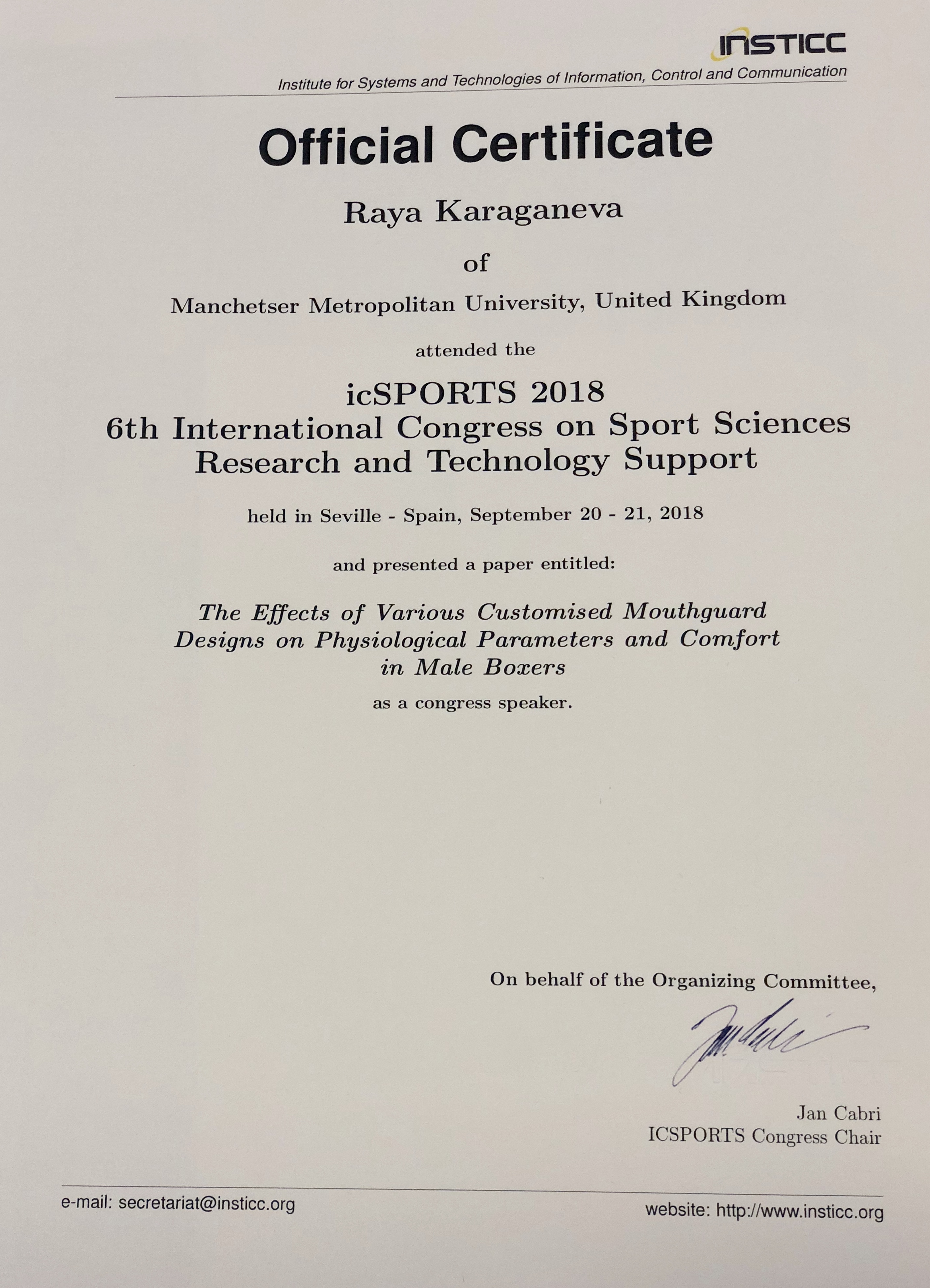
Value: £500
University: Manchester Metropolitan University
Charlotte Moroney
Auxetic Protective Equipment
I am approaching the final year of my PhD and as such giving an oral presentation was an excellent opportunity for me to disseminate my work amongst academics and researchers in the wider community. I gained some useful feedback which will feed in to the progression of the study I am currently working on. Equally, the conference brought together the ideas and developments of researchers working in various industries across the auxetics community, which helped me to think outside the box about the ways that I currently use auxetic materials in my research. In addition, as my research is based at the Manchester Fashion Institute and many of the other delegates are in engineering, sciences and technical textiles, I found the breaks in the conference particularly useful for generating conversation with researchers in other fields as well as gaining feedback and new ideas. Presenting my work in a professional environment also prompted interest from delegates working in the textile industry, who have discussed the potential of working with myself through the university on a project in the future. In particular, the delegates have offered to share the contacts that they have at sports brands which may be useful for me when I start applying for jobs and looking for opportunities in the sports industry.
The student engagement award has enabled me to attend the Auxetics 2018 conference at Sheffield Hallam University and present the work that I have produced over the past two years. From this experience I have constructive feedback and generated new ideas which will largely help me to shape and progress the final studies of my PhD.
Value: £459.20
University: Manchester Metropolitan University
Todd Shepherd
Presenting: “Validation of a finite element modelling process for auxetic structures in sports applications”
The ISEA kindly granted me the full funding of £500, which enabled me to attend the 9th International Conference and the 14th International Workshop on Auxetics and Related System with ‘Negative’ Characteristics. The conference was held at Sheffield Hallam University between the 10th and 13th September and the ISEA funding enabled me to pay the registration/attendance fees, as well as train tickets for the commute between Manchester and Sheffield each day.
The conference was well organised with delegates from over 15 countries presenting their work. I was therefore given the opportunity to present my latest findings (and receive valued feedback) to an array of experts from different areas within the auxetics field, which I enjoyed greatly, and it has provided fresh inspiration to continue working hard on my research. The conference also enabled me to network with various delegates who work on similar topics, such as finite element modelling and additive manufacturing. Hopefully, some form of collaboration can arise from this networking. I am looking forward to attending the next auxetics conference in Poznan, Poland, in 2019, where I should be able to deliver some key and final findings from my PhD. Some of the feedback received during the conference has also provided me with some alternative viewpoints on my research, which hopefully I can investigate in more detail in the coming months.
Despite living relatively close to Sheffield, I have never had the chance see the city properly. Fortunately, we were taken on a very informative and entertaining walking tour on one of the afternoons and even saw a building whose design looked as it was inspired by auxetic structures. The conference meal at the famous ‘Cutlers Hall’ was also an experience that won’t be forgotten in a hurry.
All of this was made possible by the full support of the ISEA and meant that I could completely immerse myself in the experience of an international conference once more – thank you very much.
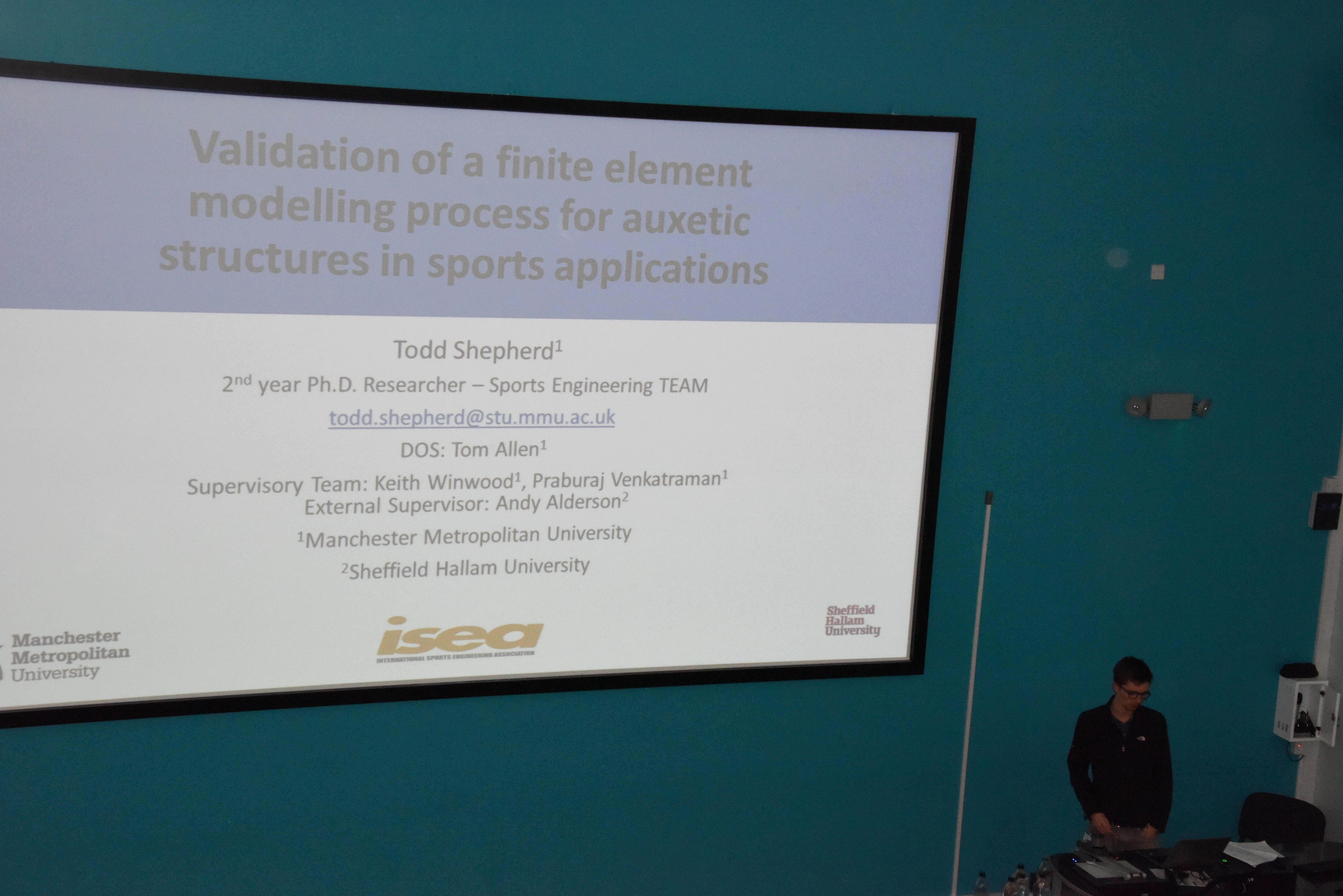
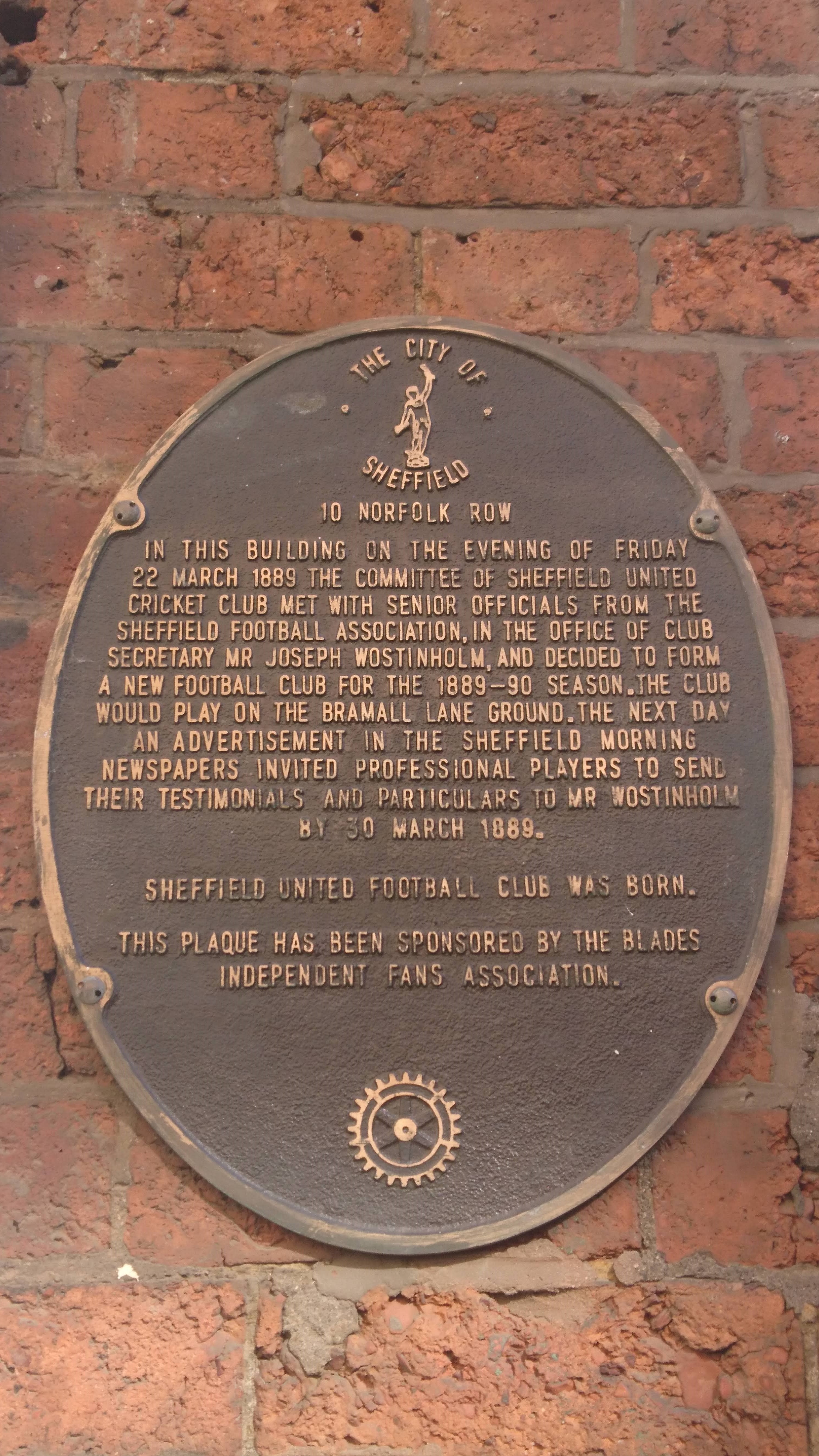
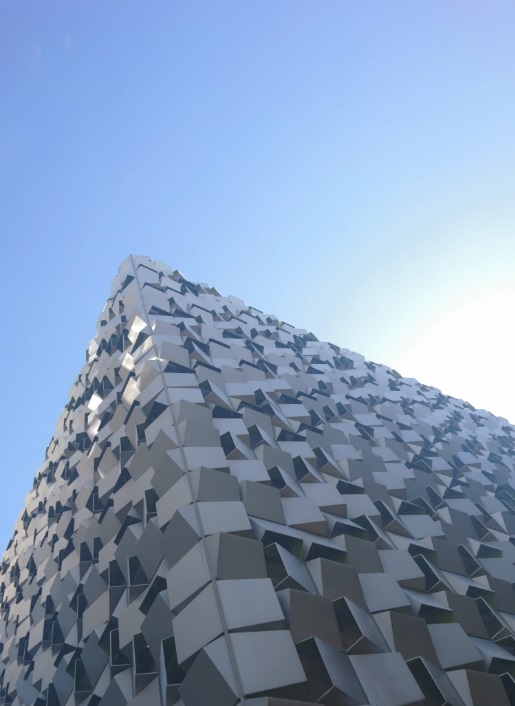
Value: £500
University: Manchester Metropolitan University
Julia Wilfling
Spinfortec conference in Garching, Munich
As a masters student at the UAS Technikum in Vienna we annually have a measurement week in winter where students can choose topics to work on with own interest. The topic I was working on with some colleges had the title “in-situ tests with touring skins”. Focus of this project was to detect the static and sliding friction coefficient considering different touring skins in the glide and the grip direction of a skin. We had companies sponsoring us with touring skins and supporting our project.
Finally I got accepted at the spinfortec conference in Munich to present our project. At the congress I had the chance to attend a lot of interesting presentations regarding sports engineering, biomechanics and sport analytics. I am continuously inspired how wide the topic is I am studying for. I met professors from different universities in Germany and had a talk with representatives of different companies who were sponsor of the congress. Presenting my work at the conference allowed me to improve my presenting skills, handle better my nervousness and also broadened my network with people of the sports engineering industry. I had a talk with one of the professors after my presentation and he was really interested and told me about similar studies he undertook. The most important thing about attending conferences is networking! The talks I had have all little relevance to my future career.
By supporting my participation of the congress I covered all the costs regarding entrance fee, travel costs as well as accommodation. I also could take part in the “munich evening” where everybody of the conference (lecturers and students) had dinner together at a relaxed atmosphere. Thank you for supporting me!
Value: £500
University: UAS Technikum Wien
Ashley Bagley
The effect of the bend on global kinetic and temporal variables during the block phase of the sprint start
The ISEA student Engagement Award was used to help subsidise my transport and accommodation costs while visiting German Sport University Cologne to loan custom-made instrumented starting blocks and corresponding software to be used for my 1st PhD study.
As a result of the trip, a collaboration is emerging with Dr Steffen Willwacher, firstly to investigate the differences between global kinetic (average external block power and ground reaction forces (GRFs) in all three planes of motion) and temporal (contact time in the blocks) variables during the block phase of the sprint start on the bend and the straight. Ten sprinters, all experienced in bend sprinting (200 m PBs ranged 21.40 – 23.20 s), completed three 10 m maximal effort sprints on the straight and three 10 m maximal effort sprints on the bend in lane 1 (radius 36.5 m). The sprinters all started from the instrumented starting blocks. Results showed that there were no differences in the performance variables including total push time and normalised average horizontal block power. For the front block, external force production in the vertical and resultant forces were significantly different. On the bend, the mediolateral forces in both blocks were directed more towards the centre of the track. The results demonstrated that in the starting blocks, the bend does not impact on performance variables but technique in applying force changes.
The study will be written up with the aim of it being published in the Journal of Sports Sciences. My abstract has also been accepted as a free communication presentation as the BASES Conference 2018 in Harrogate.
Dr Steffen Willwacher will be an external member of my PhD supervisory team. The opportunity to meet with the researchers and engineers at the German Sport University Cologne and discuss how novel sports engineering projects and collaborations might be developed further was a very valuable experience. I was also given the opportunity to speak at a seminar during the visit, a fantastic opportunity for feedback on my work. During the trip, I was shown around the University and their facilities, the starting blocks, the set-up and how to use the equipment.
The collaboration with Steffen allowed access to state-of-the-art equipment for data collection, which will advance our understanding of the reasons for performance decreases on the bend, compared with the straight. I would like to thank Steffen Willwacher and the ISEA for the opportunity to visit German Sport University Cologne, borrow the equipment and develop collaboration with an academic who is well published in another country. This has been valuable experience as I look towards completing my PhD.
Value: £500
University: Sheffield Hallam University
Ryan Martin
Measuring behaviour conference 2018
The primary use of the funding was to attend the Measuring Behaviour conference at MMU including travel. The conference was based around the study of human and animal behaviour, a day was also dedicated to sports engineering which gave an insight into how I could carry on my studies in this field. The event was multi-disciplinary with a variety of researchers, I attended many talks over the 3 days learning about software/hardware that is in development stages and asked could it be used in sports engineering once completed. It was a device designed to limit lumbar issues by alerting the user that they are in a ‘dangerous’ position throughout the day. On the sports engineering day I displayed my final year project poster concerning the degradation of running shoes, this got some interest as it was a novel method of testing that people hadn’t expected and changed the way they thought about how the shoes degrade through use. Some of the interest also started debates between couples saying “I told you so” to their partners.
The most important thing about attending conferences is networking, many of the talks had very little relevance to my future career and some were extremely complex and hard to follow. During the breaks and events following the talks I began talking to an array of people, one of these people was asking me about my project and said they had a contact in industry who may be interested in my report and findings. Nothing came of it this time, but it might have, the more contacts and chances you have the more likely you are to find a career.
Value: £245
University: Manchester Metropolitan University
Sam Stagg
Application of inertial sensors as a method of monitoring fatigue in boxing
The ISEA Student Engagement Award was used in order to help me subsidise my transport and accommodation costs while participating in a Sports Engineering internship based at Griffith University, Nathan Campus. Having access to the ISEA grant was extremely beneficial for me as it allowed me more financial stability when settling into my role as a sports engineering intern in Australia.
Upon completion of the placement a full report on the analysis on the placement of inertial sensors on the body and their application for monitoring fatigue in boxing was submitted to Griffith University. Our initial hypothesis for the use of the inertial sensor located at thoracic vertebrae 3 (T3) was as follows: 1) The sensor data obtained would be suitable to replace the wrist sensors used in prior studies to measure acceleration, gyration and magnetometer readings 2) Distinguish between a right and left punch being thrown 3) detect fatigue occurring in an athlete and 4) identify when a punch has landed and its attenuation throughout the body. The two participants used were elite level athletes competing at the Gold Coast Commonwealth Games and tests were performed in training involving a fixed wall bag, a trainer using focus pads and sparring sessions
From the study we were able to determine the IMU sensor placed at T3 was indeed suitable for monitoring boxing performance in various scenarios and determining left/right punches was possible along with their corresponding magnitudes. It was deemed the use of the T3 sensor was favourable due to it being place in a less invasive position. However there was less success when monitoring fatigue levels during these trials and the results from the study were inconclusive.
I would like to thank Griffith University and the ISEA for their support throughout my placement the opportunity to study and complete a research project in another country has been a valuable experience for me as I look towards completing my degree.
Value: £500
University: University of Leeds
Thomas McGuckian
Using inertial measurement units to investigate visual exploration in a novel football passing task
After presenting at the European College of Sport Science congress in Dublin, I travelled to Germany to collaborate with Adam Beavan (Saarland University/UTS PhD candidate) on a research project. I would like to thank the ISEA Student Engagement Award for funding this component of my trip. The funding helped cover the costs of transport and accommodation, allowing this project to go ahead.
The data collection involved the quantification of exploratory head movement using inertial measurement units while football players completed a novel football passing task. With this data, we will investigate how the exploratory action before players receive a pass influences their ability to perform a subsequent pass. Data analysis will involve the synchronisation of the IMU data with video footage, coding of video footage and processing of the IMU data with a custom designed algorithm. The output will give an understanding of various qualities of exploratory action and how these influence subsequent actions with the ball. This is a relatively new area of research, so the findings will go a long way to informating our understanding of visual exploration in football.
The collaboration with Adam allowed access to high level players for data collection, which will give an excellent insight into how highly skilled athletes use visual information to guide passing actions in football. This investigation is the first of many potential collaborations, even after both Adam and I complete our PhD studies, and the ISEA has played a significant role in making this possible.
Year: 2018Value: £500
University: Australian Catholic University
Matteo Aita
Kinematics and feature negotiating feedback system in a ski cross start and run: a methodological study
As a Msc student in Sport technology at Aalborg University, for my Master thesis project I investigated a method to develop a performance feedback system for ski cross skiers and coaches. My supervisor was Professor Uwe Kersting and the project was in collaboration with the Swedish Ski Cross Team. I want to say thank you to the ISEA for funding this project. The funds were used to cover the travel and living expenses for one month in Are, Sweden.
Three elite skiers of the Swedish Ski Cross Team participated to this study. The equipment was composed by a wearable IMU-based motion capture system to collect the skiers’ kinematic data, and two GNSS sensors to collect the skier’spositioning data along the full ski cross course. The test course included all the features typical of a ski cross run, such as turns, jumps, rollers, banks and negative turns. The mobile sensor was integrated in the back protector and worn by the subjects, and the base sensor was placed at the start. The positioning data from the two sensors were post-processed together to increase the data accuracy by applying the relative positioning technique. The files containing the kinematic data were then converted into c3d files and fused with the files containing the positioning data into a new c3d file in MATLAB. The new c3d file was successively imported in Visual3D, where the kinematic data of interest, i.e. the pelvis-feet distance along the three anatomical axes, and the pelvis and feet trajectory along the whole run were analysed.
Value: £500
University: Aalborg University
Sebastian Walton-Adams
An insight into how the use of Inertial Measurement Unit sensors can play a role in shot classification in cricket batting
My research work at Griffith university gave an insight into how inertial sensors can be used in the game of cricket. Trialling these sensors firstly with bowling but completing my final report on batting. As researchers we looked at placing an inertial sensor on the thoracic vertebra to see what data could be recorded. This was the most practical and viable place to put a sensor as it can be used in a real game scenario. After using two elite batsman in manipulated and real game trials we recorded data onto a bought software to interpret it (Matlab). Our findings showed that when batsman’s recorded data in manipulated trials patterns emerged which could be identified and quantified. A sensor seemed to be able to detect when a ball was hit and trends on graphs could indicate what type of shot was played (shot classification). However, data recorded in a real game scenario was more problematic. Due to the numerous degrees of freedom in cricket batting it was problematic to interpret output graphs, especially when compared to the initial trials. In the future we hope that the sensors improve in order to record accurate and higher ranged data.
Overall, a big step was taken in this specific field and the idea holds huge viability in the game of cricket. Hopefully the next step is for my written up paper to be published and cricket teams become aware of the potential these sensors have in the future to record quick information elite players need when batting. Work on the IMU sensors at Griffith is ever increasing and improving to produce a exceptional IMU sensor.
Year: 2018Value: £500
University: Griffith University
William Dawber
Characterisation of tennis racket parameters - Wimbledon AELTC.
The grant allowed me to assist Dr. Luca Taraborelli with the research for his paper on the historical development of tennis rackets from codification in the 1870s until present day.
Myself and Dr. Taraborelli visited the All England Lawn Tennis Club where we had the privilege of working in the Wimbledon Tennis Museum, here we had access to around 1000 tennis rackets dating back to the 1870s. During the week-long trip we were able to evaluate around 100 of these rackets on several parameters including geometric, inertial, dynamic and manufacturing properties. My role was to take measurements on racket swing speed and calculate values of transverse and polar moment of inertia for each of the rackets. All of this data is now being documented alongside a further 300 other rackets already tested in order to investigate the effects these changes in design have had on performance. Going forward I plan to continue my work with Dr. Taraborelli to further aid in the production of his paper by helping with research and testing.
I am a BEng Sport Technology undergraduate at Sheffield Hallam University with an ambition to further research in Sports Engineering. This trip provided me with valuable hands-on experience testing sports equipment, furthered my understanding of correct research procedures and boosted my knowledge of design development and the effects it has on performance.
The first outcomes of this project were presented at the ISEA 2018 conference in Brisbane and were appreciated by the audience. Since our trip, Dr. Taraborelli presented his updated results at the ISEA sponsored Sport Engineering Seminar Day at Manchester Metropolitan University on the 2nd May 2018 where I was in attendance. It was great to see the reception he received for his hard work and how the Sport Engineering community is continuously growing and demonstrating its impact on industry.
Thank you to the ISEA for their generous funding. Without this, the trip would not have been possible for me. The funding paid for return travel from Manchester to London, accommodation near to the club, food and drink for the week and transport in London. The experience I have gained has been priceless and I hope to use this as a building block to one day make impact on the Sport Engineering community.
Value: £400
University: Sheffield Hallam University/ Manchester Metropolitan University
Chloe Newton-Mann
2nd Sports Engineering Seminar Day – 2nd May 2018 – Manchester Metropolitan University
On Wednesday 2nd May 2018, Manchester Metropolitan University held a Sports Engineering Seminar Day, which was organised and run by PhD students from the university. The ISEA and IET sponsored the event. Our aim was to promote Sports Engineering in an academic environment, raise awareness of the subject and disseminate work in this field within the UK.
The day began with a tour of facilities including the Manchester Fashion Institute, Print City (Additive Manufacturing), engineering workshops and human movement lab. There were four key themed sessions throughout the day including ‘Sports Apparel and Biomechanics’, ‘Health and Injury Prevention’, ‘Simulation in Sports’ and ‘Materials and Equipment Mechanics’. We had industry speakers from Pentland Brands (Speedo & Canterbury), Defence Science and Technology Laboratories and ANSYS, as well as academics and PhD students from UK universities – Manchester Metropolitan, Loughborough, Sheffield Hallam, Chichester and Strathclyde.
Over 110 people from 12 universities, 11 companies and students from a local college joined us for the day, attracting new audiences to Sports Engineering. There were prizes awarded for best student presentation (including Speedo prize), best poster, two student engagement awards and best tweet. Our twitter feed for the day can be found @SportsEngUK or using the #SESday. Feedback forms (and discussions) indicated the event was again very well received, although some people would have liked fewer talks to allow more time for discussion. There was clear interest to continue making this an annual event in the Sports Engineering calendar, and Loughborough University will take on the role of host in 2019. We would like different institutes to host the event on a rotational basis, facilitating travel from different areas of the UK while helping to keep the event fresh, encouraging new industry partners, and university students and staff to attend. Continued interest in the event will help to build up a UK hub of sports engineers, inspiring a new generation to come through and join the ISEA. We would also like to set up a community for all Sports Engineering PhD students to communicate and share ideas, with possible funding going towards further networking.
Finally, we would like to thank the ISEA for sponsoring the event, without the sponsorship it wouldn’t be possible. I believe many people made new contacts and explored new collaborative projects in turn growing the sports engineering community in the UK.
Some quotes from the day:
“#SESday @sportsengUK. It is obvious that the importance of Engineering will always help improve sports in general and help to strengthen unity & love all over world, ethnic groups, professionals & educational backgrounds. Thus, kudos to the organisers of Sports Engineering seminar. Great event. Looking forward to the next one soon.” – Student
“Thanks to everyone for all the hard work making the event a success, I thought it was great. Hopefully if there is another seminar next year I’ll finally be able to stay for the drinks afterwards!” – Industry representative
“Thanks again for inviting me to present at the seminar. I thoroughly enjoyed the event and I’ve benefited from gaining a number of new contacts and research insights.” – Industry representative
“Thank you and well done for ensuring the presentations and day ran smoothly yesterday, not an easy task. We look forward to welcoming you to Loughborough next year.” – Academic Lecturer
Value: £500
University: Manchester Metropolitan University
P.Abishek Jerome, Francis Samruth
Additive manufacturing of Auxetic Materials for Sport Equipments
Through our senior colleagues we came in contact with Dr. Tom Allen and the Manchester Metropolitan University. Due to our immense interest in Material Science and Additive manfacturing we were delighted to get the opportunity to work with the advanced equipment in MMU to synthesize Auxetic structures for Sport safety equipment. The duration of our project was between 18th January and 18th March 2018.
The main objective of our project was to successfully manufacture re-entrant auxetic structures using a Lulzbot 3D printer, which is capable of exhibiting negative poisson ratio and high Impact resistance.
The result we were able to learn was the methodology to successfully control the structure of the auxetic using various settings and document it. This can be further used to build complex auxetic structures useful for the sports Industry.
We had the opportunity to meet people from various departments and cultures and were able to share ideas for the betterment of our project. Since we were given the full wheel on the project we were able to fully understand the nuances of our work which helped us to improve our project management skills tremendously.
We being International students, the funding helped us in and out of the project and made sure that we were able to complete our project successfully. The funding covered our material costs, travel costs, etc.
Finally we were able to explore a new range of possibilites in Material science through this project. We learnt about the future of materials in sports industries and also on how materials play a pivotal role in safety and protection.
After this we will be pursuing our Masters and hopefully land a job in the sporting industry. We wish to thank ISEA for being making this tremendous opportunity a succesful journey.
Value: £1000
University: Manchester Metropolitan University
Jake Popperwell
Use of inertial sensors and their placement on the body to detect boxing performance
The funds provided to me by the ISEA helped me with travel and accommodation costs whilst living in Australia. This enabled me to fully focus my time on the role as a Sports Engineering research intern at Griffith University. I focused my research on looking into the use of inertial sensors to detect boxing performance. By the end of the internship we had completed an extensive research project that has the potential to be published into the Journal of Sports Engineering.
The paper reported a quantitative assessment of sensor placement to detect magnitudes in boxing using IMU data. Our hypothesis stated the 3rd thoracic vertebrae sensor would be able to:
- Be used instead of wrist sensors to detect acceleration, gyration and magnetometer outputs of punches.
- Distinguish between a left and a right punch using sensor data.
- Detect fatigue in an athlete.
- Identify when a punch lands and its attenuation throughout the body.
The funds provided to me by the ISEA helped me with travel and accommodation costs whilst living in Australia. This enabled me to fully focus my time on the role as a Sports Engineering research intern at Griffith University. I focused my research on looking into the use of inertial sensors to detect boxing performance. By the end of the internship we had completed an extensive research project that has the potential to be published into the Journal of Sports Engineering.
The paper reported a quantitative assessment of sensor placement to detect magnitudes in boxing using IMU data. Our hypothesis stated the 3rd thoracic vertebrae sensor would be able to:
- Be used instead of wrist sensors to detect acceleration, gyration and magnetometer outputs of punches.
- Distinguish between a left and a right punch using sensor data.
- Detect fatigue in an athlete.
- Identify when a punch lands and its attenuation throughout the body.
It was determined that an IMU sensor placed at T3 is suitable to monitor boxing performance in some scenarios. It is possible to determine both left and right punches along with their magnitudes when observing punch profiles and taking into consideration their time delay. Overall the use of a sensor located at the T3 is more favourable than located at the wrist due to being less invasive, smaller acceleration peaks and reduced chance of being damaged during testing. When testing fatigue the results were inconclusive with the peak acceleration increasing over the seven sets where it was hypothesised to decrease. Both the pad work and sparring trials were again able to identify left and right hand punches with a varying degree of accuracy however there was evidence that the sensors do have the capacity to be used in a dynamic environment.
Further research is needed in order to determine whether the T3 is as optimal as the wrist for detecting fatigue and whether the increased acceleration is being caused by an over acceleration at the shoulders. A more in depth analysis of each type of punch would allow a clearer understanding of if (and how) individual punch characteristics differ from one another in their punch profiles. Finally, research into the development of a machine learning model would provide a better understanding in how possible it is to use an automatic points scoring system in a competitive scenario.
As an undergraduate student I will be returning to Leeds to finish my BSc degree in Sport and Exercise Science (Industrial). However colleagues at Griffith University will continue the work with these sesnors to further analyse boxing performance.
Year: 2018Value: £500
University: Griffith University
Kristina Brubacher
The 8th Asia-Pacific Congress on Sports Technology 2017
The ISEA Student Engagement Award was used to cover my transportation cost to attend The 8th Asia-Pacific Congress on Sports Technology (APCST) 2017. The conference was held on 15th to 19th October 2017 in Tel Aviv, Israel. The APCST is a major international event in the field of sports technology, organised biennially.
I had the opportunity to present my conference paper titled ‘Design of sports compression garments: exploring the relationship between pressure distribution and body dimensions’. The paper forms part of my PhD research on the design of sports compression garments for female athletes. I presented the results of an online survey that I conducted with sports compression garment users as well as key findings from my wearer trial study with commercial compression sportswear. My research is very interdisciplinary in nature and with a background in clothing and textile technology, it was imperative for me to strengthen my international connections in the sporting field. I really enjoyed that the conference featured presentations from both academia and industry. I learnt a lot from the academic presentations from a wide range of fields related to sports technology, such as sensors, wearable technologies, materials and sports equipment. These presentations were complemented by great keynote presentations from industry experts. Yonatan Gorfung (Deloitte’s Innovation Tech Terminal) gave a very interesting presentation about future trends in sports technology, whilst Dr Matthew Nurse (VP / Nike Explore Team Sport Research Lab) and Dr Randy Wilber (US Olympic Committee) gave insights into the development and application of new technologies. The common thread amongst these presentations was not to forget the end users in new developments - a principle that has always guided my research.
Thanks to the support from the ISEA Student Engagement Award I fulfilled my aims of disseminating my research at an international level and broadening my network within the sporting sector. My focus is now on working towards the submission of my PhD thesis in early 2018. I look forward to meeting colleagues from the APCST again at future conferences to further strengthen relationships and potentially grow future collaborations.
- Christina Brubacher presentation
- Dr Matthew Nurse presentation
- Welcome – Prof. Mickey Scheinowitz
- ISEA Members
Value: $500
University: Manchester Metropolitan University
Oliver Duncan
Effect of time and temperature on auxetic foam fabrications (oral) and Comparisson of Digital Image Correltaion and marker tracking methods for strain measurement in open cell foam
ISEA's contribution allowed me to attend the 9th International Conference "Auxetics and other materials and models with "negative" characteristics" and 14th Workshop "Auxetics and related systems", September, 2017, Crete.
Two objectives from my PhD (auxetic foams for sporting protective equipment) were presented. These included an assesment of a strain measurement method and an auxetic foam fabrication study. My overall aim is to set up a test to quantify the effect of foam's negative Poisson's ratio on indentation resistance. Auxetic foam is closer in modulus and density to materials used in sports protection than other auxetic materials. Open cell foam used in comparisons is ~3 times less dense and has a very different compressive stress strain relationship (buckling beyond ~10% compressive strain, when the auxetic sample is relatively linear to 80% compression). These extra variables have prevented clear relationships from being demonstrated between Poisson's ratio, indentation resistance and peak force under impact.
The first (poster) presentation compared digital image correlation (DIC) and marker tracking for strain measurement in open cell foams. DIC has not been widely used for foams. Presented work shows it to be comparable to marker tracking and it has already managed to identify the effect of flaws in foam cell structure. Further work will measure material flow under an indenter. Most attendees had not used DIC in this way, but those fabricating auxetic foams and fabrics were keen to try, with possible applications in smart garments for apparel.
The second (oral) presentation suggested methods to reduce variables (density and modulus) in comparisons between auxetic and non-auxetic foams. Previous comparative auxetic/non auxetic foam impact and indentation studies don't control changes to density and compressive modulus. A clear link between indentation resistance and Poisson's ratio cannot be made in scenarios close to those seen in sporting collisions, or required for certification by sporting standards. Discussion around the specifics of the test set up and a request to test for shear modulus will help clarify the reason for any differences in the indentation resistance of positive/negative Poisson's ratio samples.
Outputs include collaborative work with researchers from the Georgia Institute of Technology and a chance to discuss a collaborative study with the University of Malta (submitted as a full paper for 'The Engineering of Sport' in Brisbane). I was also lucky enough to meet a PhD student from the Liverpool John Moores University, modelling indentation of auxetic materials for heel protection in basketball shoes. The conference was an excellent event and I received useful advice. I hope that members of the ISEA can attend next year's Auxetics conference (here at Sheffield Hallam).
Value: £500
University: Sheffield Hallam University
Megan Kenny
Research Project – Using IMUs to predict ground reaction force when sprinting
I used the award to help fund a trip to Griffith University, Australia to complete a research project. The project involved using inertial measurement units (IMUs) to collect acceleration data to then predict the ground reaction forces involved in a sprint start.
As part of the project myself and another intern travelled to Australia via Japan. In Japan we had the opportunity to conduct some trials using the facilities there to collect data for the project. We both visited the National Institute of fitness and Sport (NIFS), Kanoya and we able to make use of the instrumented running track and athletes there. Three sprinters completed 10m and 50m sprints over an instrumented running track that collected three dimensional force. The sprinters were also were also wearing IMUs developed by Griffith University on each shank and the T3 vertbrae, which would collect accelerometer, gyroscope and magnetometer data. Me and the other intern were also kindly given a tour of the facilities and the local area by Professor Tomohtito Wada from NIFS.
The project was then continued in Australia where all the data analysis took place. I was working as a part of a group of people wit the aim to to develop a method or algorithm to be able to predict the ground reaction force from the acceleration data from the IMUs. We then had to think about ways of using the acceleration data to get the force. A couple of different methods were tried by various members of the group. The method I worked on was to use a linear combination of the accelerations to create a model that would give an estimation of the force. The result showed potential, for one of the participants a model was created that could reasonably accurately predict the ground reaction force generated.
Completing the project was a really great experience, I really enjoyed working on the project and am happy to have contributed to research in this area, as the project resulted in a paper that is going to be presented at the ISEA 2018 conference.
Value: £500
University: Imperial College London
Todd Shepherd
Presenting ‘Finite Element Modelling of Auxetic Materials for Sports Applications’
Thanks to the generous funding from the ISEA, I was able to travel to Tel Aviv, Israel, and attend my first international conference – the 8th Asia Pacific Congress for Sports Technology. The money I received went towards my registration and attendance fees, as well as contributing to my stay at a conveniently located Airbnb, close to the conference venue.
I presented my work to date on ‘Finite Element Modelling of Auxetic Materials for Sports Applications’, showcasing my latest finite models as well as physical prototypes of structures created using additive manufacturing techniques. The conference allowed me to disseminate my work to other experts in the field of sports engineering and also provided the opportunity of networking and potentially collaborating with some of the attendees. I was also able to attend talks on other interesting and related topics within sports engineering.
The whole experience was enjoyable and has given me the thirst to experience more international conferences in the future. The conference should provide me with a solid foundation that I can build on with my next two years of PhD studies.
As part of the conference, I was lucky enough to be taken on two organised tours to see some historical sites of Israel. The first tour was around the old town of Jaffa, also known as the gate to Jerusalem; a beautiful ancient port steeped in history and tradition. To finish my trip in Israel, a visit to the town of Caesarea was arranged. Here I saw an archaeological park that was aiming to restore some of the former ancient ruins, as well as a hippodrome that doubled up as a concert venue and a former seafront palace.
Without this generous funding, my trip would not have been possible – so again thanks to the ISEA for supporting me.


Value: £500
University: Manchester Metropolitan University
Ehsin Farooq
ISEA Placement Funding
With the financial support from the ISEA I was able to successfully complete my voluntary work placement at the ITF. This funding provided the financial assistance required to allow me to make the most out of a valued opportunity. The high financial pressures entailed with travel and accommodation within London were greatly eased and therefore allowed me to work to best of my ability in all work carried out. In addition, it provided me with the confidence and means to prepare as effectively as possible beforehand knowing that finances were in place prior to my placement, this relived much pressure and again allowed me to focus on being ready for the work carried out while at the ITF.
From this experience I was therefore able to gain an invaluable insight into the technical theory and testing procedures involved in tennis, from surfaces and balls to software. I was able to learn how to use the advanced machinery responsible for evaluating all these technical aspects of the sport, whilst gaining a better understanding in the process. Alongside many industry professionals I was also able to observe and take part in many different tasks gaining expert advice and training, which i look to consolidate on in the future. This would not have been achievable without the financial support from the ISEA.
In the immediate future I believe that this funding and completion of my placement will enable me now to implement this newfound experience and skills into my third year of university whilst also challenging me to approach tasks with a new perspective. Fundamentally I will now look to apply and draw upon this knowledge and experience in all future university projects. I believe this again will prove invaluable towards the duration of my course.
On reflection I was able to gain an amazing insight into my area of study beyond a university environment and crucially understand how the theory i have learned is translated into a practical working environment. The result is that I could take my first big step within the sports engineering industry, gaining invaluable first-hand knowledge in the processes. It has also hopefully set me on the right path to becoming an accomplished sports engineer and provide the early foundations towards the future, where i hope to make positive impact and contribute towards the wider field.
Value: £500
University: University of Strathclyde
Bodil Oudshoorn
Visiting Griffith University, Brisbane and Gold Coast, Australia
Purpose of the visit
To visit Professor David Thiel (Griffith University, Engineering department) and Jonathan Shepherd (SABEL labs & Griffith University) to learn more about the use of inertial sensors for measuring gait and posture, and attend the 13th biennial Footwear Biomechanics Symposium held by the Gold Coast campus of Griffith University.
Summary of visit
At the start of my trip I visited the engineering department of Griffith University (Nathan Campus). David Thiel and Jonathan Shepherd had organised a seminar for my visit. In this seminar I presented a new strand of research that CSER (Centre for Sports Engineering Research) is currently undertaking, on the development of test methods to assess the safety of sports equipment. Afterwards Jonathan had organised a lab-tour of the campus and showed how their in-house developed IMU (inertial measurement units) worked and what they were currently used for.
The second part of my visit was located an hour South of Brisbane, in the Gold Coast. The three-day conference on Footwear Biomechanics research was very applicable to my own PhD research project, where I am using biomechanical data to inform a new test method to assess the laceration injury risk of studded footwear. Prior to the conference we had submitted a research paper and research proposal to be considered for the Nike Award for Footwear Research. Our project had previously been selected as a runner-up for this award. After an extended presentation session our project was chosen as the winner of the 2017 Nike Award.
Altogether, it was a fantastic trip where I have met some great people who I hope to work together with in the future. It further has helped me understand the possibilities and current use of IMU's and I believe this trip has raised attention to the research that is needed to develop test methods for assessing the safety of sports equipment.
Year: 2017Value: £500
University: Sheffield Hallam University
Jonathan Shepherd
As I am now embarking on my final year of my PhD program disseminating my sports engineering research internationally is imperative to both strengthen my final dissertation and foster relationships. Furthermore, as the ISEA student member on the executive committee it is important for me to liaise with other students to ensure the ISEA is meeting their specific needs. The ISEA funds partially contributed to my airfares and expenses (e.g. conference registration fees and accommodation) to assist me visiting Europe to present at three conferences (Manchester, London and Delft).
On this trip I spoke at three conferences and spent two days at the Centre for Sports Engineering Research (CSER) at Sheffield Hallam University.
- Shepherd, J. Theil, D. Espinosa, H.(2017) Using Inertial Magnetic Sensors to approximate fatigue performance metrics in boxing. Science and Engineering Conference on Sports Innovation. Delft, Netherlands.
- Shepherd, J. (2017) Engineering Sport through Virtual Reality: Can we enhance performance and heighten fan engagement. UK Sports Engineering Summit. Manchester, United Kingdom.
- Shepherd, J. James, D (2017) Data, data, data…but what about feedback? Sports Analytics Summit, Innovation Enterprise. London, United Kingdom.
I achieved both my intended goals, in firstly engaging with other academics and industry end-users which will help shape my thesis and with diversifying my professional networks. This resulted in many new connections, with potential research collaborations emanating from this when I complete my PhD at the end of this year. Furthermore, as a direct result of this trip, one student now undertaking a internship with us at Griffith University from the Netherlands.
At each of these conferences I actively promoted the next ISEA conference (which I am on the organising committee for) and chatted to students in particular about the ISEA, what they want out of their membership, and how they can be involved.
Year: 2017Value: £500
University: Griffith University
Chloe Newton-Mann
Sports Engineering Seminar Day
On Wednesday 29th March 2017, Manchester Metropolitan University held a sports engineering seminar day. The ISEA, MMU School of Engineering and the IET sponsored the event. Our aim of the day was to promote sports engineering in an academic environment, raise awareness of the subject and disseminate the work being conducted in this field of research.
The day started with a tour of the university facilities including the Manchester Fashion Institute, Engineering Workshop and the Movement Lab. Following a networking lunch, which included posters and equipment being displayed, a series of themed sessions of presentations were held. The four key themes were ‘equipment mechanics’, ‘healthcare and injury prevention’, ‘biomechanics’ and ‘sports apparel’. We had speakers from industry including Evotech CAE Ltd, Ansys, Cantebury and our keynote speaker Paul Barratt from the Great Britain Cycling Team/English Institute of Sport. We also had talks from leading academics such as Carl Payton, Matt Carré and Steph Forrester as well as PhD students from Manchester Metropolitan University, Loughborough, Sheffield Hallam and Griffith University. Each presenter gave a short overview of the path taken to becoming involved in the sports engineering sector followed by information on current research/projects being conducted.
Eighty-four people joined us for the day, plus some late arrivals, making approximately one hundred attendees from MMU (20), Sheffield Hallam (15), Strathclyde (12), Loughborough (10), as well as Salford, Anglia Ruskin, Leeds and even a student from a college still picking her university degree. There were prizes awarded for best student presentation (sponsored by ANSYS), best poster (sponsored by Mitre), three student engagement awards and a best tweet (sponsored by the IET). We had banners and flyers promoting the ISEA. Jonathan Shepherd also gave a short presentation promoting the next ISEA conference.
After the event, we asked for feedback, all of which was very positive. We asked whether they enjoyed their day as well as whether they would attend an event like this again along with specific things they enjoyed/would improve. The diversity of speakers was received positively and the timing and organisation was praised.
Some key quotes include:
“It was interesting to see what kind of projects people already in the Sports Engineering field are working on. It has broadened my knowledge of possible routes to take from uni.”
“Was really interesting to find out about the different disciplines within Sports Eng. Studying MEng Sports Engineering as undergrad we focus more on product design engineering and development and biomechanics is taught from another faculty. It was good to hear how it all fitted together in industry.”
“Opportunity to mix with so many interested sports engineers and listen to so many experts presenting their research.”
We hope this event could be the start of an annual UK based sports engineering day where everybody can get together, share research and inspire the next generation. Through collaborating on research and projects, we can potentially build a UK Sports Engineering hub of excellence. If the event was held at different institutes each time, on a rotational basis, we think this would ensure a range of facilities available in the UK are showcased, encourage different people to attend and have a mix of industry partners presenting.
Lastly we would like to thank the ISEA for sponsoring the event, the funding allowed us to advertise efficiently as well as provide catering on the day which was very well received.
Year: 2017Value: £735
University: Manchester Metropolitan University
Mohamed Mufid Basha & Rohit Nagarajan
Pressure Mapping of Auxetic Foam and its Characterization
As a part of our final year project in Mechanical Engineering, I Mufid Basha and my acquaintance Rohit Nagarajan from India were really interested in doing a project on sports technology. Fortunately we got in touch with Dr. Thomas Allen from Manchester Metropolitan University through the ISEA winter school. Our project in the United Kingdom was for a time period of 6 weeks starting from the last week of January 2017 to the first week of March 2017.
The project was based on Auxetic Foam, and was supported and funded by the International Sports Engineering Association (ISEA).
Our objective in this study project was to perform pressure mapping on Auxetic foams and compare it with conventional polyurethane foams used in sports safety equipment’s. It also involved optimization by using the foam with different composites procured from the Textiles department. Since pressure mapping on Auxetic foam was an undiscovered topic, we had to initially learn a lot about how the pressure mapping equipment actually would function.
The results which were achieved through this study proved that auxetic foams have better pressure distribution properties which could eventually be used in sports protective equipments if futher study is carried on.
Our experience in the UK was very intense and helped us develop different skills. Since this project involved close co-ordination with other departments like the Textile, it also helped us gain some insight into other departmental works.
The ISEA funding was something which helped us in a big way. Being students, affording an international trip succumbed us initially. However after the formal confirmation of our funding, we were very delighted and obliged. The funding from ISEA was used for different aspects like travel, accommodation, project expenses which involved purchase of consumables, sheets etc.
Most importantly this project helped us understand what Sports Engineering is actually like and develop in us an interest to pursue this course in future. It helped us to demonstrate our analytical skills, planning and organizing the project frame work and bolstering in us the desire to learn more about sports technology. Since this project was completely left at our discretion, we were autonomous in making and executing decisions which improved our project management skills as well.
Our next plan is to take forward this project and possibly join Msc in Sports Engineering at SHU to continue futher reseach in this and diversify our study. Positvely we hope to implement this research project In something that would prove benefical for the sports community.
Certainly this was a great and different experience we were exposed and it created interest in sports engineering to a large extent.
Value: £1000
University: Manchester Metropolitan University
Caroline Adams
19/05/17 International Society for Skiing Safety Congress (ISSS)
Funds were used to cover the costs of transportation, conferences fees and a portion of accommodation costs.
The ISSS is a multidisciplinary conference bringing together international experts in the fields of: medicine; engineering; sports science; and ski tourism, to enhance the safety of winter sports through scientific research. In April experts from all around the globe gathered at the sport science faculty at the University of Innsbruck. The main themes of the conference were epidemiology of winter sports injuries; ski racing; avalanches; health aspects of skiing; head injuries, knee injuries; equipment; biomechanics and ski bindings. Whilst the conference is multidisciplinary at least a third if not more of the presentations constituted sports engineering.
I presented a study I have completed during my PhD on the design of surrogates to mechanically test snowboarding wrist protectors. It was interesting to see the complementary approaches being taken by different research institutions and have the opportunity to receive feedback on my work. Positive discussions were had with other researchers both concerning mechanical testing and the potential to influence behavioural practice and track the impact of a prevention once an ISO standard has been established. Chloe Newton Mann who is supporting the wrist protection work through FEA simiulation also had the opportunity to present her early work and proposed approach.
The use of equipment as a means of injury prevention was discussed throughout the conference. A change in ski binding design has resulted in a drop in tibia fractures but the number of ACL injuries has increased. This highlighted the importance of taking into consideration the full chain of the human body when implementing changes. Another intervention discussed at length was despite the increase in helmet use across resorts up to 97% in some countries the rate of head injuries doesn't reflect this change in behaviour. Given the prevalence of these injuries it appears that sports engineers in collaboration with resorts, clinicians and manufacturers have a responsibility to better understand the mechanism of injury and aid the design, development and testing of improved products. This could in time lead to changes in policy and a revision to the helmet standard. A number of innovative approaches are being taken to better understand these injury scenarios and develop representative tests.
Year: 2017Value: £500
University: Sheffield Hallam University
Caroline Adams
International Standards Working Group Meeting ISO/TC 94/SC 13/WG 11 - Body & hand protection for snowboarding : April 28-29 2016, Switzerland
Funds were used to cover the costs of transport and a portion of accomadtion. The remainder of the costs were covered by the British Standards Institute.
Injuries to the upper extremities are the most frequently reported injured body region in snowboarding and contribute to 35-45% of all snowboarding injuries. Wrist protectors have been shown to reduce injury risk, yet there is no minimum performance standard these products should conform to. This can leave consumers confused and mislead about their safety. The International Standards Organisation has established a working group with the aim of developing a new standard - ISO/TC 94/SC 13/WG 11- Body & hand protection for snowboarding. As my PhD project is focused on the testing and design of wrist protectors I have become the nominated UK expert on this committee. This means I participate in technical working group meetings 2-3 times per year and provide the committee with advice based on the body of work completed during my PhD.
This particular meeting was held at the BFU headquarters (Swiss Council for Accident Prevention) in Bern Switzerland. The meeting started with discussions around the time frame of the project and key dates in the ISO & CEN process were outlined by Ruth Schnieder - Secretariat SNV Swiss Association for Standardization. The draft standard should be completed by September. This will then be circulated to all relevant national bodies for review (typically over a period of 6 months). If the review is successful the process for implementing an ISO standard will commence if not then it will be transformed into a European Standard. The next meeting to finalise the draft will be held in August 2016 at Manchester Metropolitan University (MMU) hosted by Tom Allen & Caroline Adams. As the EU PPE directive will be held in Leeds March 20-24th 2017 and both Peter Gyger and Ruth Schnieder will be there anyway it was agreed informally that there will likely be a follow up meeting during that week.
I presented an overview of the work I've completed within my PhD titled "Development of a new method to characterise snowboard wrist protectors". This includes a critique of EN 14120 inline skating protectors, which has been identified as the starting point for the new standard. Key weaknesses include: (1) inappropriate test setup which can't be conducted based on the schematic; (2) poorly designed prosthesis/surrogate shape; (3) threshold values not based on published injury mechanism data; (4) ambiguous test protocol with no consideration given for strapping tightness. During a study (to be presented at ISEA conference July 2016) we have demonstrated that strapping tightness affects whether products pass or fail. Given that products will be tested by different operators globally it's important this is addressed to ensure repeatability.
Given that gloves with integrated protection are on the market there is the need for a new surrogate with fingers and a method which the load can be applied at a set distance. At Sheffield Hallam we are currently developing a new surrogate design based on geometry obtained using 3d body scanning technology. As standard needs to include 2D schematic and associated dimensions for a range of sizes this couldn't be used directly, but could help in advancing the shape of the surrogate. In addition to this we are developing a clamping mechanism which can be mounted externally onto the surrogate wearing the glove at a fixed distance so a bending moment can be applied without cutting the glove. Future work will include the development of a dynamic impact test and FEA work performed by Chloe Mann (MMU PhD student). Which we hope can support a later revision of this standard further down the line.
The remainder of the two days were spent going through the latest version of the standard and addressing comments and concerns from members of the committee on the themes of:
• Impact performance requirements and testing
• Stiffness performance requirements and testing
• Splint dimensions
• Conditioning samples
Next Steps: Prior to the next meeting in Manchester Bfu & SNV will update the standard to reflect corrections and discussion during the meeting. This will then be circulated to the rest of the ISO committee. Bfu will coordinate the design of new surrogate including dimensions and cad drawings (potentially delegating this to Sheffield Hallam but yet to be confirmed). I will test a wider range of products providing plots for angle vs torque for the current state of the market. Based on this at the next meeting we can collectively make an informed decision on performance parameters for the bending tests.
Year: 2017Value: £290
University: Sheffield Hallam University
